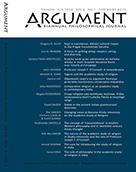Kept in translation: Adivasi cultural tropes in the Pragat Purushottam Sanstha
Kept in translation: Adivasi cultural tropes in the Pragat Purushottam Sanstha
Author(s): Gregory D. AllesSubject(s): Indian Philosophy, Culture and social structure
Published by: Wydawnictwo Uniwersytetu Komisji Edukacji Narodowej w Krakowie
Keywords: bhagat movements; Bakrol; Bhadaran; Chhotaudepur; Dahyabhai Maharaj; Narayan Muni Maharaj; Ramanavami; Purushottam Maharaj; Rathvas; Swaminarayan Hinduism;
Summary/Abstract: This article considers a little studied branch of Swaminarayan Hinduism, the Pragat Purushottam Sanstha, whose headquarters are located in Bakrol, Anand district, Gujarat. It is specifically concerned with the results of the activities of this branch among adivasi (tribal) people in the Chhotaudepur district in eastern central Gujarat, results that are of the sort that were once frequently referred to as ‘Sanskritization’, but that I prefer to call, with a nod to local terminology, ‘bhagatization’. The article first situates the Pragat Purushottam Sanstha within the broader family of Swaminarayan communities, contrasting it with another, much better known community, the BAPS Swaminarayan Sanstha, with whom it shares an early lineage. Then it identifies ways in which participation in the Sanstha has led adivasi people to replace some of their traditions with practices drawn from the outside. Although it is common in the area to view people who participate in a community such as the Pragat Purushottam Sanstha as abandoning adivasi traditions altogether, this article suggests that such a view is misleading. Drawing inspiration from James Clifford’s work with cultural translation and Greg Urban’s work with cultural transformation, it suggests that the Sanstha exemplifies one way in which elements of adivasi culture persist when adivasis translate their traditions into settings marked by increasing contact with globalizing modernities.
Journal: ARGUMENT: Biannual Philosophical Journal
- Issue Year: VI/2016
- Issue No: 1
- Page Range: 143-162
- Page Count: 20
- Language: English

